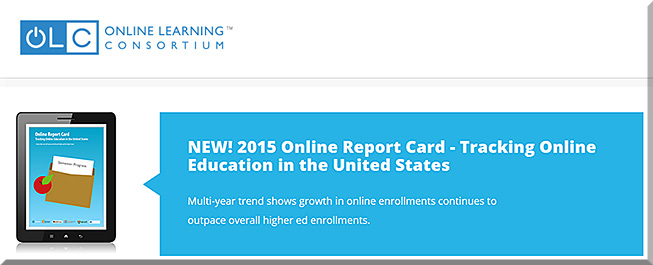NEW! Online Report Card – Tracking Online Education in the U.S. — from the Online Learning Consortium
Excerpt:
Key report findings include:
- A year-to-year 3.9% increase in the number of distance education students, up from the 3.7% rate recorded last year.
- More than one in four students (28%) now take at least one distance education course (a total of 5,828,826 students, a year-to-year increase of 217,275).
- The total of 5.8 million fall 2014 distance education students is composed of 2.85 million taking all of their courses at a distance and 2.97 million taking some, but not all, distance courses.
- Public institutions command the largest portion of distance education students, with 72.7% of all undergraduate and 38.7% of all graduate-level distance students.
- The proportion of chief academic leaders that say online learning is critical to their long-term strategy fell from 70.8% last year to 63.3% this year.
- The percent of academic leaders rating the learning outcomes in online education as the same or superior to those in face-to-face instruction is now at 71.4%.
- Only 29.1% of academic leaders report that their faculty accept the “value and legitimacy of online education.” Among schools with the largest distance enrollments, 60.1% report faculty acceptance while only 11.6% of the schools with no distance enrollments do so.
Also see:
- Babson bids good-bye to enrollment numbers — from Carl Straumsheim
The 13th and final annual report on online education enrollments by the Babson Group shows how much the market has grown since 2002 — and how little it has changed.
Excerpt:
The Babson Survey Research Group is ending its influential report on the number of students who study online and how chief academic officers feel about the delivery method, citing a “coming of age” of the online education market. Yet the 13th and final annual report, released [2/9/16], shows that perceived skepticism among faculty members toward online education remains, and that many colleges continue to have no interest in online courses.









